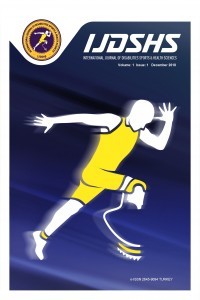Extent of Knowledge and Application the Basics of Biomechanics Among Paralympic Games Coaches
Extent of Knowledge and Application the Basics of Biomechanics Among Paralympic Games Coaches
Paralympics, Biomechanics, Application Coaches, Knowledge Range,
___
- Chawla, N. (2017). Biomechanics in Physical Education Application of Biomechanics in Teaching Physical Education. International Journal of Enhanced Research in Educational Development (IJERED). Dutt, S. (2018). Role of biomechanics in physical education and sports. National Journal of multi-disciplinary Research and Development, ISSN, 2455-9040. Higgs, C., Babstock, P., Buck, J., & Parsons, C. (1990). Wheelchair classification for track and field events: a performance approach. Adapted Physical Activity Quarterly, 7(1), 22-40. İslamoğlu, A.H., Öndar, E., Yıldırım, T., & Kartal, Z. (2023). Determination of Anthropometric Measurements and Nutritional Status of Wheelchair Basketball Players. International Journal of Disabilities Sports and Health Sciences, 1-9.
- Lopes, J., Guimarães, K.A., Lopes, S.M., Pérego, S.M., & Andrade, C. (2023). Analysis of biomechanics in athletes with disabilities: a systematic and narrative review. Fisioterapiaem Movimento, 36, e36201.doi. org/10.1590/fm.2023.36201
- Maly, M. R. (2009). Linking biomechanics to mobility and disability in people with knee osteoarthritis. Exercise and sport sciences reviews, 37(1),36-42.DOI: 10.1097/JES. 0b013e3181912071
- Mauerberg-deCastro, E., Campbell, D. F., & Tavares, C. P. (2016). The global reality of the Paralympic Movement: Challenges and opportunities in disability sports. Motriz: Revista de EducaçãoFísica, 22, 111-123. doi.org/10.1590/S1980-6574201600030001
- O'Riordan, A., &Frossard, L. A. (2006). Seated Shot Put–What’s it all about?. Modern Athlete and coach, 44(2), 2-8. Özkaya, N., Leger, D., Goldsheyder, D., &Nordin, M. (2016). Fundamentals of biomechanics: equilibrium, motion, and deformation. Springer. Reina, R., Elvira, J. L., Valverde, M., Roldán, A., &Yanci, J. (2019). Kinematic and kinetic analyses of the vertical jump with and without header as performed by para-footballers with cerebral palsy. Sports, 7(9), 209. Romanov, R., Stupar, D., & Medjedovic, B. (2022). The Effects of Kinesiology Treatment on Morphological Characteristics of Top Table Tennis Players with Disabilities. International Journal of Morphology, 40(4). Silva, A. S., Barreiros, A., & Fonseca, A. M. (2019). Exploring the importance of coaches in the development of the sports career in Handball. The perception of athletes from higher and lower levels of success. Cuadernos de Psicologíadel Deporte, 19(1),106-120.doi.org/10.6018/ cpd.314221
- Trowell, D., Vicenzino, B., Saunders, N., Fox, A., &Bonacci, J. (2020). Effect of strength training on biomechanical and neuromuscular variables in distance runners: a systematic review and meta-analysis. Sports Medicine, 50, 133-150. Watkins, J. (2014). Fundamental biomechanics of sport and exercise. Routledge
- Yayın Aralığı: Yılda 3 Sayı
- Başlangıç: 2018
- Yayıncı: Nevzat DEMİRCİ
Omid MONFAREDİAN, Mohammadreza AMİRSEYFADDİNİ, Negar KOOROSHFARD, Mohammad ALİMORADİ, Roya BİGTASHKHANİ
Every Camp Has a Story: Barrier Free Youth Camp with Teacher Narratives
Atike YILMAZ, Serdar KOÇ, Mustafa HAN, Şevval AKAYDIN
The Role of Sport in Acceptance of Disability and Resilience
İsmail AKTAŞ, Ekrem Levent İLHAN
Özgür AYDOĞAN, Naile Hande YAZICI, Devrim TARAKCI, Esra ATILGAN
Murat KALAYCI, Asiye Hande BAŞKAN
Yavuz YASUL, Enes AKDEMİR, Salih ÖNER, Berna ANIL, Esra KORKMAZ, Mine PEKESEN KURTÇA, Ali Kerim YILMAZ
Enhancing Classroom Learning Outcomes: The Power of Immediate Feedback Strategy
